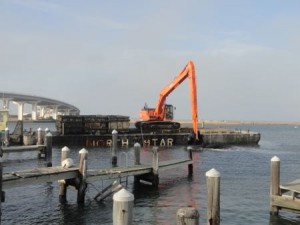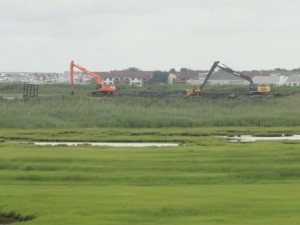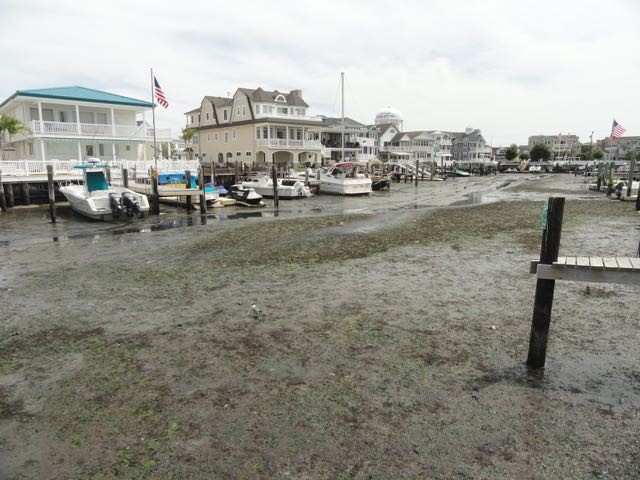It is Ocean City’s $20 million problem.
Not only will it take a lot of money to clean out the city’s notoriously clogged lagoons, it will take a lot of time, Mayor Jay Gillian and representatives of an environmental consulting firm warned Monday night during a town hall meeting.
Gillian has proposed spending $20 million to dredge the shallow lagoons along the back bays as part of his $98.5 million citywide capital plan for the next five years.

However, he told residents at the town hall meeting that, without a new plan for disposing of dredged material, the costs could balloon much higher. New surveys have estimated that as much as 1 million cubic yards of mud and silt must be dredged. Under the current program of hauling away material by truck to make room for new projects, it would cost about $80 per cubic yard, which could raise the total price tag to about $80 million.
“It’s costing a fortune,” Gillian said in frustration.
The city will look for funding help from the state and federal government to help solve the crisis.
“Obviously, we couldn’t do the whole thing,” Gillian said of maintaining the current program.
The city is also exploring options to find more cost-effective and sustainable solutions, while it ponders the enormous financial implications.
ACT Engineers has been hired by the city to devise some short-term solutions as well as a long-range strategy for the dredging problem.
ACT Engineers gave an update of its efforts during the town hall meeting at the Ocean City Free Public Library, but its representatives also expressed their frustrations about the potential costs and regulatory obstacles.
“We all know that this is very costly for you as taxpayers,” said Carol Beske, the company’s project principal.

Beske stressed that the dredging program has been complicated by a litany of regulatory regulations imposed by the state and federal environmental agencies that oversee the permits for the city.
Beske characterized it as “obstacle after obstacle.”
But she also joined with the mayor in expressing confidence that the city will ultimately overcome the problems to get the lagoons cleared out — at some point.
“It’s painstakingly slow, but at least we’re trying something,” Gillian said.
Gillian urged residents to work with the city on a lobbying effort aimed at getting state lawmakers to pass legislative reforms that would ease the regulations.
One key for getting the short-term dredging program on track is the proposed emptying of a disposal site on Roosevelt Boulevard near the 34th Street Bridge. Yet environmental restrictions have slowed down the process for building a temporary road that would help trucks haul away dredged material more efficiently.
Site 83 currently was filled to capacity at 300,000 cubic yards of dredged material before a contractor removed about 40,000 cubic yards in a painstaking journey by barge and truck.
Representatives of ACT Engineers said further clearing of the material will allow the city to continue its dredging efforts.
The city anticipates a contractor will be permitted to build the road starting in March, and it will take an estimated 75 days . Although the road would allow more trucks to empty the disposal site even faster, it will still take about a year to get the job done, said Eric Rosina, project manager for ACT Engineers.
Rosina, though, said more trucks would save the city about $4 million to $5 million in disposal costs compared to the slower process of removing the dredge materials by barge and truck. He also said that the trucks could complete the work in about a year, compared to more than three years if barges alone hauled away the material.
Delays with removing mud and silt from another disposal site near the Ninth Street causeway slowed down the dredging of Ocean City’s Snug Harbor last year. The project had to be halted on Dec. 31, before the work was completed, because the regulatory window for work expired.
Snug Harbor’s contractor, Wickberg Marine Contracting Inc., had a $937,900 contract for the project, but representatives indicated the city is negotiating terms related to an incomplete job.
The city is discussing the possibility of bringing back a contractor to finish Snug Harbor’s dredging and nearby areas, allowing private slip owners to piggyback on the city’s environmental permit to hire their own contractor.
Snug Harbor, along Bay Avenue between Eighth and Ninth streets, had been so choked with mud and silt that residents could get their boats only at the highest tides. The contractor dredged some of the lagoon but ran out of time before it could move on to privately funded work to eliminate the shelf of mud that most boats sit on.
“What can we do? We still can’t use our boats,” said resident Dave Beyel, whose house at the bay end of Eighth Street overlooks Snug Harbor.






